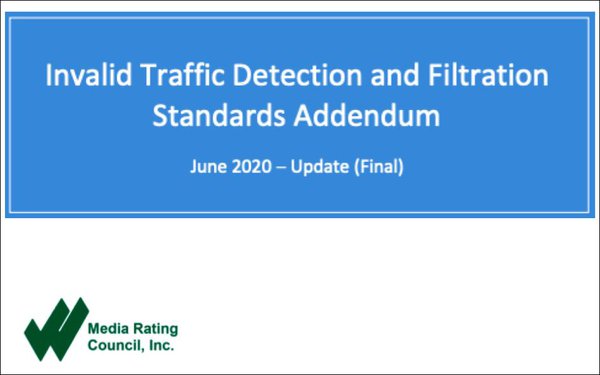MRC 'Modernizes' 5-Year-Old Invalid Traffic Standards To Account For New Forms Of Ad Fraud
- by Joe Mandese @mp_joemandese, June 25, 2020
The Media Rating Council (MRC) this morning officially released new standards intended to “modernize” how the advertising and media industry manage a key component of digital ad fraud: so-called “invalid traffic,” or IVT.
The update is an addendum to the MRC’s “Invalid Traffic Detection and Filtration Guidelines,” which were originally issued nearly five years ago, to account for new forms of fraudulent traffic threats that did not exist when the original guidelines were created.
The MRC said it established a regular process for updating its IVT standards, because it recognized that ad fraud is like a continuous arms race of innovation by fraudulent sources and detection and adoption by the ad industry, but today’s update is the first time it has issued a comprehensive overhaul superseding “all previous updates.”
The updated standards will also be applied to any measurement services applying for first-time MRC accreditation or for continuing accreditation, but the MRC said currently accredited services will have a “one-year grace period, beginning today” to become fully compliant with the updated standards.
While the guidelines are highly technical, they essentially set an industry standard for determining if and when digital traffic used as the basis for ad impressions is non-human and illegitimate, often because of some devious technology such as spiders, bots or another mechanism is used to fraudulently represent real people.
Some of the key revisions included in the updated standards include:
The addition of more specific Sophisticated Invalid Traffic (SIVT) areas.
The addition and updating of previous interim guidance on data center traffic requirements.
The addition of specific requirements on risk assessment by platform and relevant traffic segment, as well as a requirement to directly link these to specific controls for each.
New requirements to disclose a “decision rate” metric (defined as the percentage of all impressions intended for measurement where sufficient information was obtained to make a valid or invalid decision), along with definitions, calculations and requirements for supporting partial detection decisions.
The addition and updating of previous interim guidance on requirements and disclosures associated with sampling approaches to IVT detection and filtration.
New requirements for the treatment and disclosure of purchased and acquired traffic.
The formalization of requirements, previously documented in MRC’s Brand Safety Supplement, for the use of Machine Learning and Human Intervention in IVT detection practices.
The addition and updating of previous interim guidance on up-front filtration requirements.
The addition and updating of previous interim guidance on mobile in-app requirements and added OTT-specific considerations.
The addition of guidance and requirements for logged-in and subscription-based environments.
New detailed IVT discrepancy resolution procedures and requirements.




Joe, thank you for your report, but I would like to suggest a correction to your sentence in the fifth paragraph which currently states:
"While the guidelines are highly technical, they essentially set an industry standard for determining if and when digital traffic used as the basis for ad impressions is non-human and illegitimate, often because of some devious technology such as spiders, bots or another mechanism is used to fraudulently represent real people."
I encourage you to make sure your readers know the phrase "essentially set" should be understood as "set essential industry standards." It's important readers of this article understand the distinction. In this case, the standards are not just good to know concepts. The standards are mandatory protocols for entities who seek accreditation.
Let's use your company, Mediapost, as an example. At some point, I imagine you will be interested in learning the metrics associated with the all of the paid advertising campaigns that have run on Mediapost. For example, you will probably want to know how many impressions did the advertising campaigns generate, and so on. The entities you work with who are responsible for collecting, processing, and reporting those metrics are held accountable, meaning that whatever metrics are reported, the responsible entities should have handled the data in the most valid, reliable, and effective manner. If not, then the metrics shared with you and your advertisers are suspect. However, if standards are met, then the metrics shared with you and your advertisers are regarded as being approved by our industry. As you are a business owner, I encourage you to consider the best practice of only working with entities that have passed their respective audits and are accredited.
I very much enjoyed your article. Thank you for letting our industry know of these important developments.